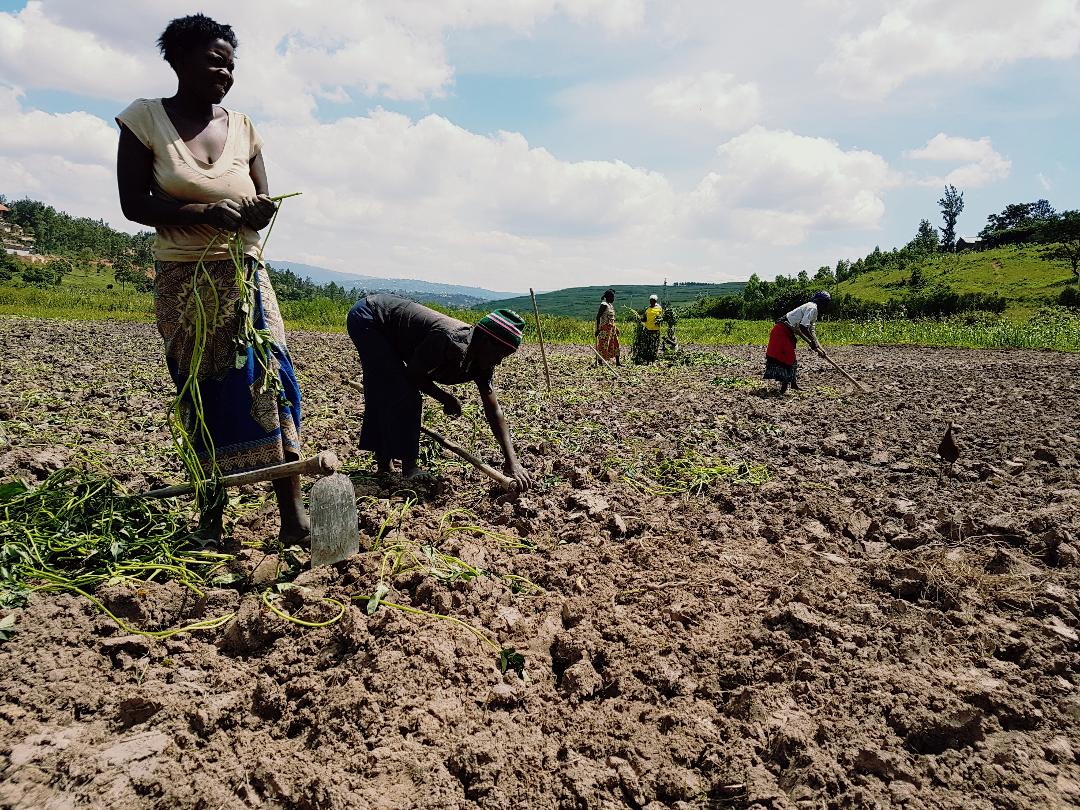In the marshlands of Kinyinya, just north of Rwandas’s capital city Kigali, Chantal Mukamana, a widow with six children, is one of 120 people working on a 20-hectare farm.
The land here is owned by the government but leased to large-scale farmers and farming co-operatives, worked by day labourers like Mukamana, who earns the equivalent of $3 (around £2.50) for an eight-hour shift.
The farm grows a range of crops, from potatoes and sorghum, to plantain and egg plant, for both export and domestic consumption. But unexpected heavy rains this year destroyed 11 million Rwandan Francs’ worth of crops, according to the farm supervisor, Aimablé Rushriabwoba.
“Because of the heavy rain, we lose everything. This season because of flooding, we didn’t gain anything,” says Mukamana. “This change is new.”
For workers like Mukamana, an unpredictable, changing climate means not only fewer crops to harvest and less work for her, it also means having to find more money to pay for food, as prices have already begun to rise. “When the climate has changed it affects the work and feeding the family is not easy,” she says.

Food systems globally are being threatened by climate change and rising temperatures. From food availability, to access, and even quality. The presence of heavy rains and drought have a disastrous effect on food production and consequently the livelihoods of those dependent on agriculture.
According to ActionAid, agriculture accounts for 33 per cent of Rwanda’s GDP, with women like Mukamana contributing up to 70 per cent of the country’s agricultural labour.
Ammar Kawash, who coordinates the World Food Programme’s (WFP) farm to market alliance, which works with smallholder farmers to improve their yields, says the agency had received anecdotal reports of a 20 to 30 per cent loss of harvest and damage to agricultural land due to the recent floods from the farms on their Rwanda programme.
“The average maize yield is around two tonnes per hectare. Farmers here in Rwanda on average have a third of that which is 700kg. That is what they are depending on. If you are losing that, you are losing 700kg of potential food that you will consume, and you would sell to the market, so the impact of losing a crop is devastating,” he explains.
The rainy season in Rwanda usually starts in February and ends around May but has in recent years continued into late June.
“Irrigation is a huge potential un-locker of resources but again these types of infrastructure projects are extremely costly. We in the development community and ministry of agriculture have very ambitious targets for increasing the amount of irrigated land. These are things that don’t affect farmers in the developed world because they have access to all this infrastructure,” says Kawash.

In an attempt to deal with the changing climate, over the past year, the government has been working with the country’s meteorology centre in Kigali to generate weather forecasts that are then texted to farmers, and broadcast on radio.
Anthony Twahirwa, weather manager at the meteorology centre, says: “For farmers, we generate different ranges of forecast ranging from six to 20 hours and three to five days. We issue them every day. We send that bulletin to the ministry, extension officers around the country and other end-users like farmers and co-operatives.
“The government comes and tells us this season it is better to plant this type of crop because of the drought or heavy rain,” says Mukamana.
For the WFP’s Kawash, climate information is one thing but without proper mitigation measures, like irrigation and insurance for farmers in case of loss, it is an incomplete circle.
“The level of development in Rwanda is pretty low in general despite all the excellent progress that has been made over the last 10 years. It’s an extremely costly exercise to do,” he says. “We are not talking about a million or two, we are talking about hundreds of millions of dollars for a small country like Rwanda.”
And until money is found, it is Rwandans who feel the pinch as the destruction of the harvest continues to drive up food prices.
Hassina Niwemugeni runs a fruit and vegetable stall at the market in Kimironko, Kigali. “The food has increased in price and customers are now buying less. It is going to get worse because if we are buying at high prices, then we have to sell at high prices,” she says.
Rapid population growth, rising temperatures and changes in weather patterns are putting many countries around the world at risk and Africa has been said to be in the “eye of the climate change storm”, according to the World Economic Forum.
Kigali, in Rwanda, is only one snapshot of the risks that growing African cities like Dar es Salaam, Addis Ababa, Luanda and Lagos are projected to experience.
Wana Udobang was a 2018 Great Lakes Reporting Fellow with the International Women’s Media Foundation.












0 Comments